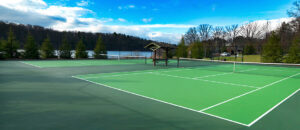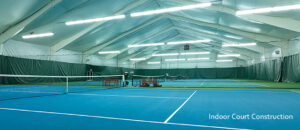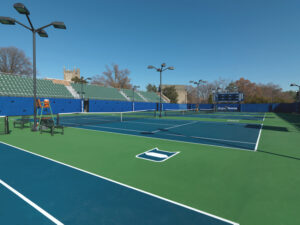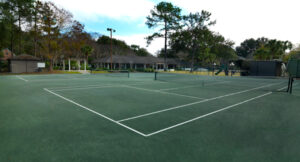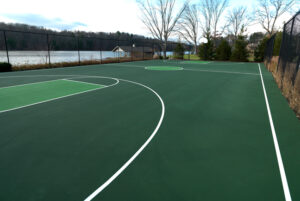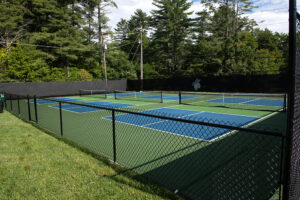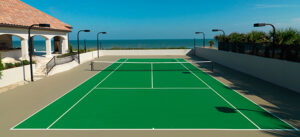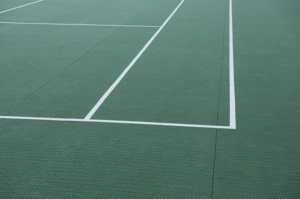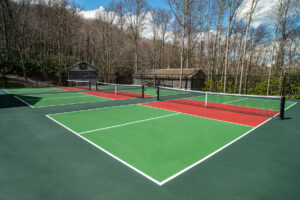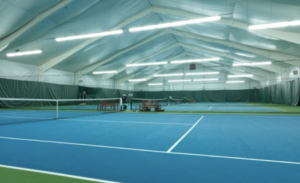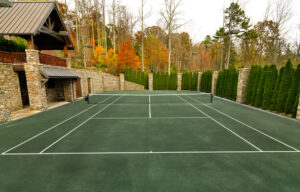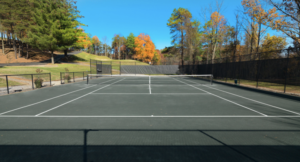Here are a Few Tips for Preparing Your HydroCourt(s) for the Spring
Hydrocourts:
1. Control Boxes: Make sure to re-install the drain plugs and turn the water system back on. Also, check to make sure that the valve for the court’s drain line is closed. Check the float valve to make sure that it is operating correctly and that any hard freezes haven’t damaged the valves or box.
2. Drainage: Make sure that the ground around the low side of the tennis courts (the side to which the water drains) is below the height of the curb. If it is not, water will be dammed up on the court surface and the affected area will drain much more slowly than the rest of the court and flood much sooner after a rain. Also, remove any excess material which has accumulated on this same side of the court, as it will also cause a damming affect when it rains. A 12″ wide ditch with a positive flow away from the courts should work to remove the excess surface water in normal rain conditions.
3. Dead Material: Remove all dead material from the court surface. Dead material is any HydroCourt material which no longer has any fines in it. Typically, this material will accumulate under the net, around the sides and in the corners of a tennis court. The dead material should be saved as it can be re-used if heavy winds deplete the court’s surface material.
4. Line Tapes: Check all of the lines and replace any worn or torn tapes. Old tapes can be a hazard to the players as they become very slippery when worn. We recommend replacing all of the lines on a HydroCourt every 2-3 years in the South and as needed in the North. Copper nails are expensive, but they can usually be saved and re-used. Aluminum nails are much less expensive and generally work best when new, so we do not normally recommend using them again.
5. Nets: Clean the head band with some strong mildew remover. After cleaning, spray on a good silicone or Armoral type preserver. Check to make sure the side lacing is secure and that the anchor pipe holding the center strap is clean and rust free. Now would also be a good time to check the center strap, in particular the double-snap hook which connects it to the anchor pipe.
6: Net Posts: Wire brush, prime and re-paint all net posts. Special care should be taken with the crank if the crank is exposed to the weather. Internal crank posts should be sprayed with silicone or some other lubricant to ensure against oxidizing and locking up. If your posts are bent, they can be re-heated by a welder and pulled back into shape. If the poles are pulling up the concrete base, it is best to dig them out and re-set in a new foundation. Typically this hole should measure 2.5′ x 2.5′ x 3′ utilizing 3,000 psi concrete. Posts are set 42′ apart.
7. New Material: Add new material to the court(s) as needed. Generally you want to add at least 20 bags to the court in the spring (50 bags over the entire year). Pay close attention to the wear areas such as the baseline and the doubles net area. Make sure that the court is a light grey in color and therefore dry, before adding any new material. Also, it is a good idea to scarify any areas that you are patching before you apply the material. Drag and water immediately after adding the material. Roll at least three times after the court has dried. The courts will be soft for a week or two, but play is the best thing for them, so after you have finished the rolling, by all means let the play begin.
8. Sterilize: Place a good vegetation sterilizer within 12″ both inside and outside the perimeter curb. A border of at least 12″ is necessary to prevent encroachment of weeds, grasses and roots. Follow all directions when applying weed killers and sterilants.
9. Lights: Check all fixtures for rust, loose bolts and loose connections. Pay close attention to any signs of wear. Clean and paint where necessary. Completely clean the lens of the lights. As much as 50% of your lighting can be lost with dirty lenses.
10. Equipment: Oil and lube your roller and/or power unit. Clean and repaint any metal that has rusted or shows sign of wear. Check oil, plugs, tires and hinges for wear. Check all of your brooms and line sweepers making sure that you have spare brushes and brooms. You can get by not rolling the courts for a few days, but the court lines must be brushed daily and the court should be broomed twice a day at least.
11. Roll, Roll, Roll: If your courts freeze in the winter they will need a lot of rolling in early spring. You can add some weight to the roller to help with this process but nothing works better than simply rolling the surface – a lot. If you do leave your lines down be careful not to turn or twist with the wheels or the roller while riding on the lines. This process may take a week or two so be patient and keep at it.

